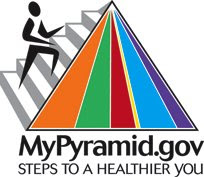
In Chemistry this week, we're talking about energy, and when we talk about energy, a lot of times, we're talking about heat (energy flowing from one place to another). You are also learning that the energy needed to raise the temperature of a substance, like water, is called a calorie.
Wait a minute. I thought calories had to do with food?
Well, calories are related to food. You just use the word "calorie" a little differently. When the "calorie" is associated with caloric intake, you are actually referring to the heat (energy) released from the chemical reactions that take place in your body when you eat food and then break the bonds between all of those little molecules in your food. So if a particular food has a lot of "calories", that means that more heat can be released by breaking its bonds than other foods. The amount of energy that can be released is not to be confused with whether or not the food is good for you. A candy bar may have a lot of calories, but it has few nutrients that you actually need and has lots of stuff in it that you don't need. It also gives you the kind of energy that gets used up really quickly, but leaves you with oils and fatty materials that hang around in your body a long time.
All of the activities you do during a 24 hour period require different amounts of energy. Running, for example, requires a lot more energy than jus sleeping (which does require energy, by the way.) So because different people have different energy requirements, that means that a healthy diet varies depending on who you are.
In class, I want you to go to the USDA's food pyramid website and find MyPyramid Tracker (on the right side menu). We're going to do three things: 1) Calculate your caloric intake. 2) Calculate your Energy Requirements. 3) Compare the two.
To do this, scroll down to "Check it Out" and click there. You can register as a user for free later if you want to use the tools you're about to see on a regular basis.
Now fill in your information about how tall you are, etc. This will help the tracker identify how many calories you use for any given activity.
Click on "Proceed to Food Intake." Here, you can type in foods that you eat on a normal day. To find your food on the list, type it in, hit "Search" and select what you want from the list that appears. Click "add" for each food.
When you are happy with your list of foods for one day, click on "Select Quantity." Now you can tell the Tracker if you would normally eat an entire pizza or just one slice (big calorie difference!). When you are finished with that, click "Save and Analyze."
Now you have two options. Choose the first on - "Calculate DG Comparison," which will compare your intake to what is healthy. Take a look around.
Now scroll back to the top of that page and find the little sphere labeled as "Physical Activity Entry." Choose the "Standard Option" when asked. Now you are going to make a list of what activities you perform on a daily basis. To choose from a complete list of activities instead of thinking them up on your own, you can click on the "Select" button and choose from the detailed list that shows up. Add each activity you want and when you are finished, "Select Duration."
Now is the hard part - make those activities fit in a 24 hour period. When you are finished and everything adds up to 1,140 minutes' worth of activities, tell the Tracker to analyze your activities. Choose the to calculate your physical activity score. This is your energy requirement for one day.
Now go back to the spheres at the top of the page again and choose the one that says "Energy Balance." This will compare the amount of calories you need to what you actually take in on a typical day.
How do your numbers compare? People who take in fewer calories than they need will lose weight as they bodies get the energy they need from anywhere they can get it - usually fat reserves in the body. People who are taking in more calories than they need tend to gain weight because their bodies make the executive decision that just in case a famine occurs in the near future, all of that energy ought to be saved. The energy gets saved as fat, which is not that big of a deal if you live somewhere were famines occur. The problem is that in the U.S., famines don't occur too terribly often. Food is pretty readily available for most folks here and a lot of that food has a high caloric content. A great deal of U.S. citizens live pretty inactive lives (not like you guys, who have practice before school, go to school, go to athletics, go to practice after school, then go home and work some more), eat out all the time, and eat a lot every time they eat. Not good.
Put this data in your science journals on the same page as your estimated caloric requirements that you calculated in class.
As I mentioned earlier, this tool is available to anyone, is free and if you register (also free) you can use this tool to track your intake and needs on a daily basis. You can also find information about what a healthy diet should look like for you based on your energy requirements. Pretty cool, huh?
No comments:
Post a Comment